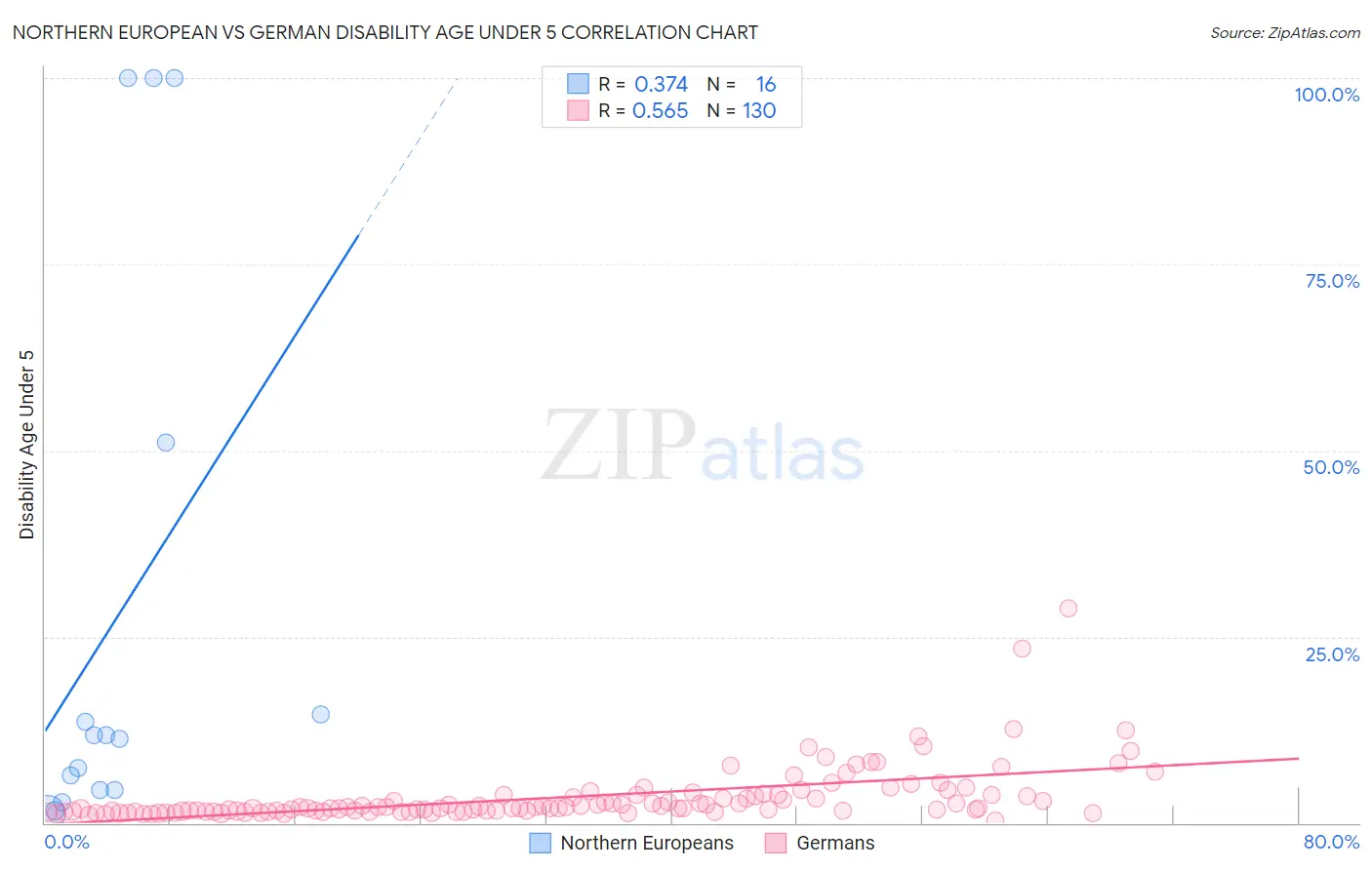Northern European vs German Disability Age Under 5
COMPARE
Northern European
German
Disability Age Under 5
Disability Age Under 5 Comparison
Northern Europeans
Germans
1.6%
DISABILITY AGE UNDER 5
0.0/ 100
METRIC RATING
291st/ 347
METRIC RANK
1.7%
DISABILITY AGE UNDER 5
0.0/ 100
METRIC RATING
322nd/ 347
METRIC RANK
Northern European vs German Disability Age Under 5 Correlation Chart
The statistical analysis conducted on geographies consisting of 214,960,262 people shows a mild positive correlation between the proportion of Northern Europeans and percentage of population with a disability under the age of 5 in the United States with a correlation coefficient (R) of 0.374 and weighted average of 1.6%. Similarly, the statistical analysis conducted on geographies consisting of 261,696,105 people shows a substantial positive correlation between the proportion of Germans and percentage of population with a disability under the age of 5 in the United States with a correlation coefficient (R) of 0.565 and weighted average of 1.7%, a difference of 10.9%.

Disability Age Under 5 Correlation Summary
| Measurement | Northern European | German |
| Minimum | 1.2% | 0.33% |
| Maximum | 100.0% | 28.8% |
| Range | 98.8% | 28.4% |
| Mean | 27.6% | 3.4% |
| Median | 11.5% | 2.0% |
| Interquartile 25% (IQ1) | 4.4% | 1.6% |
| Interquartile 75% (IQ3) | 32.8% | 3.7% |
| Interquartile Range (IQR) | 28.4% | 2.1% |
| Standard Deviation (Sample) | 37.7% | 3.8% |
| Standard Deviation (Population) | 36.5% | 3.8% |
Similar Demographics by Disability Age Under 5
Demographics Similar to Northern Europeans by Disability Age Under 5
In terms of disability age under 5, the demographic groups most similar to Northern Europeans are Czech (1.5%, a difference of 0.10%), Italian (1.6%, a difference of 0.14%), Hungarian (1.5%, a difference of 0.22%), Estonian (1.5%, a difference of 0.36%), and Scandinavian (1.5%, a difference of 0.54%).
| Demographics | Rating | Rank | Disability Age Under 5 |
| Europeans | 0.0 /100 | #284 | Tragic 1.5% |
| Croatians | 0.0 /100 | #285 | Tragic 1.5% |
| Tlingit-Haida | 0.0 /100 | #286 | Tragic 1.5% |
| Scandinavians | 0.0 /100 | #287 | Tragic 1.5% |
| Estonians | 0.0 /100 | #288 | Tragic 1.5% |
| Hungarians | 0.0 /100 | #289 | Tragic 1.5% |
| Czechs | 0.0 /100 | #290 | Tragic 1.5% |
| Northern Europeans | 0.0 /100 | #291 | Tragic 1.6% |
| Italians | 0.0 /100 | #292 | Tragic 1.6% |
| Lithuanians | 0.0 /100 | #293 | Tragic 1.6% |
| Swedes | 0.0 /100 | #294 | Tragic 1.6% |
| Finns | 0.0 /100 | #295 | Tragic 1.6% |
| Poles | 0.0 /100 | #296 | Tragic 1.6% |
| Immigrants | Nonimmigrants | 0.0 /100 | #297 | Tragic 1.6% |
| Cajuns | 0.0 /100 | #298 | Tragic 1.6% |
Demographics Similar to Germans by Disability Age Under 5
In terms of disability age under 5, the demographic groups most similar to Germans are Ottawa (1.7%, a difference of 0.57%), Scotch-Irish (1.7%, a difference of 0.63%), Chickasaw (1.7%, a difference of 1.1%), Slovak (1.7%, a difference of 1.2%), and Irish (1.7%, a difference of 1.5%).
| Demographics | Rating | Rank | Disability Age Under 5 |
| Dutch | 0.0 /100 | #315 | Tragic 1.7% |
| Immigrants | Cabo Verde | 0.0 /100 | #316 | Tragic 1.7% |
| French | 0.0 /100 | #317 | Tragic 1.7% |
| Irish | 0.0 /100 | #318 | Tragic 1.7% |
| Slovaks | 0.0 /100 | #319 | Tragic 1.7% |
| Scotch-Irish | 0.0 /100 | #320 | Tragic 1.7% |
| Ottawa | 0.0 /100 | #321 | Tragic 1.7% |
| Germans | 0.0 /100 | #322 | Tragic 1.7% |
| Chickasaw | 0.0 /100 | #323 | Tragic 1.7% |
| Cherokee | 0.0 /100 | #324 | Tragic 1.8% |
| Immigrants | Portugal | 0.0 /100 | #325 | Tragic 1.8% |
| Sioux | 0.0 /100 | #326 | Tragic 1.8% |
| Osage | 0.0 /100 | #327 | Tragic 1.8% |
| Americans | 0.0 /100 | #328 | Tragic 1.9% |
| Houma | 0.0 /100 | #329 | Tragic 1.9% |